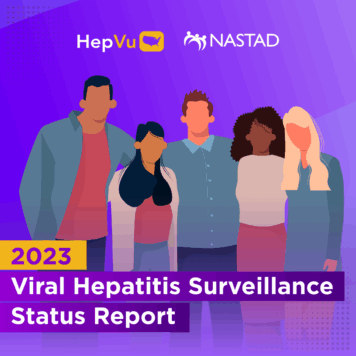Heather Bradley, PhD, is an Assistant Professor of Epidemiology at Georgia State University and serves as HepVu Project Director.
Q: Newly released data from your paper, “Hepatitis C virus prevalence in 50 U.S. states and D.C. by sex, birth cohort, and race: 2013–2016,” published in Hepatology Communications show the Hepatitis C epidemic’s continuing disproportionate burden on males, Baby Boomers, Black Americans, and, increasingly, on young people in states highly affected by the opioid epidemic. What can we learn from looking at these disparities in Hepatitis C prevalence?
The data presented in the paper reveal the continuing impact of the Hepatitis C epidemic across the country and related health disparities by sex, age, and race. The data illustrate that certain disparities are exacerbated based on geography while others remain consistent across the country. For example, as we’ve seen in previous studies, men had double the Hepatitis C prevalence of women. This is one of the disparities that was consistent in nearly every state.
Also as seen in previous studies, Baby Boomers (people born between 1945 and 1969) had higher prevalence of Hepatitis C than other age groups. Hepatitis C prevalence in Baby Boomers was three times higher than the prevalence among those born after 1969. However, this is a disparity where we also see a lot of geographic variation. Visualizing the data geographically helps us to identify states, such as Kentucky, New Mexico, Oklahoma, and West Virginia, that have higher than average rates of Hepatitis C infections among young people. In these states, we see a Hepatitis C prevalence among young people twice as high as the national average in the same age group. The states I just mentioned also have some of the highest opioid prescription rates in the country – leading us to believe that many of these infections among young people across these states may be at least partially attributable to injection drug use related to the opioid epidemic.
We also continue to see disparities by race across the country in Hepatitis C prevalece. Historically and currently, Black Americans have the highest burden of Hepatitis C compared to other racial and ethnic groups. In certain states, Hepatitis C prevalence among Black Americans was four or more times higher than among non-Black Americans, such as Washington, D.C., Ohio, Pennsylvania, Michigan, Maryland, New Jersey, and Illinois. While it is important to understand national disparities, it is also necessary to identify where these disparities are even higher than average. Understanding the distribution of Hepatitis C prevalence across states can help us better allocate resources to those communities and regions that are disproportionally impacted.
Q: Though Black Americans comprised 12 percent of the population from 2013 to 2016, they represented 23 percent of Hepatitis C infections. What are some of the potential causes behind this disproportionate impact and how can it help inform a public health response?
These days we’re hearing a lot about increases in acute Hepatitis C infections among young people, which are very concerning and likely related to opioid-associated injection drug use. However, we also need to continue to focus on chronic Hepatitis C infections, which disproportionately affect Black Americans. Black Americans have higher risk for chronic Hepatitis C for a variety of historical reasons, including differential access to quality healthcare, a higher prevalence of sickle cell disease that may have necessitated blood transfusions, and a higher prevalence of injection drug use. People, including Black Americans, who had blood transfusions before blood supplies started being screened in 1992 were highly susceptible to Hepatitis C infections.
Another important factor is the previous way we treated Hepatitis C, which was through interferon-based therapies. Likely due to a genetic mutation, Black Americans are less likely to respond to interferon-based treatments. Notably, many of these historical risk factors have changed over time – for example, Black Americans are as likely as White Americans to achieve a Hepatitis C cure with newer direct acting-antiviral (DAA) therapies – and as a result, the same racial disparities may not be seen for new Hepatitis C infections.
Q: The data indicate that younger Americans and those living in the Appalachia region represent an increasing proportion of new Hepatitis C infections. Can you elaborate on the role that the opioid epidemic and injection drug use have played in driving new Hepatitis C infections? Why have these groups in particular been so deeply impacted?
We started to see empirical increases in blood-borne infectious diseases among people who injected opioids at the time of the HIV and Hepatitis C outbreak in Scott County, Indiana in 2011. There, we saw widespread injection of an opioid called oxymorphone and a large associated cluster of HIV and Hepatits C infections. Since the outbreak in Scott County, we’ve seen other injection-related clusters of bloodborne infections in places such as Cabell County and other communities in West Virginia, as well as in several counties in Massachusetts. Notably, since surveillance for Hepatitis C is much more under-resourced than for HIV, we don’t completely know to what extent the opioid epidemic has been driving Hepatitis C infections. We do know that there’s a high level of coinfection with Hepatitis C in these investigated clusters of HIV infection.
I would also like to note that in many communities that have been hit hard by the opioid epidemic, we are seeing the supply of prescription opioids fall due to the public health response and increased regulations. However, this does not mean that people have stopped injecting drugs. In many cases, we see people move on to other injectable drugs such as heroin or methamphetamines. Heroin, methamphetamine, and other non-prescription drugs continue to be driving factors for the transmission of infectious diseases like HIV and Hepatitis C.
Q: HepVu released new resources about the stratified research, including maps, state profiles, and infographics. How does mapping Hepatitis C and illustrating the epidemic using these resources help stakeholders better address viral hepatitis – and localize the epidemic’s impact in their communities?
One of the real strengths of HepVu is its ability to visualize the Hepatitis C epidemic alongside co-occurring social factors and other epidemics, in the same way that HIV is visualized on AIDSVu. For example, the ability to look at Hepatitis C data alongside opioid data allows you to see where the Hepatitis C and opioid epidemics are co-occurring. HepVu also allows users to view Hepatitis C data in comparison to social factors, including health insurance coverage, poverty, or level of education. I think it is critical for policymakers to see these maps side by side and to understand that epidemics are related, and that addressing one problem in the absence of the other doesn’t solve syndemics. We want policymakers and health workers to have the ability to compare data side by side to better understand how the opioid and Hepatitis C epidemics can be addressed in an integrated way.
Q: There are an estimated 2.3 million people living with Hepatitis C in the U.S. What does your data reveal about the national effort to combat this epidemic and why is there an increased need for better surveillance across all levels of government?
As I previously stated, the data show that Hepatitis C disparities can vary state by state. However, Hepatitis C surveillance data remain limited, making it difficult to track and monitor geographically-specific trajectories of viral hepatitis in the U.S. These modeled estimates reaffirm known health disparities among certain populations and areas of the country and underscore the continuing need for consistent, well-grounded data. With more comprehensive surveillance, we can shed even more light on differences in Hepatitis C prevalence and help to identify the populations with the highest burden of disease. Ultimately, this can better inform public health decision-making and resource allocation for monitoring unmet needs for prevention and care services.
Educating the public and increasing awareness is fundamental – specifically, amplifying awareness for the co-occurring epidemic of Hepatitis C and injection drug use. If this trend continues, we’ll have a major problem on our hands, with more and more young people needing Hepatitis C treatment or eventually experiencing health problems like end-stage liver disease. There is an equally urgent need, however, to prevent adverse outcomes in populations who already have chronic Hepatitis C infections and may have limited access to testing or treatment, particularly among persons of color as shown by our data.




